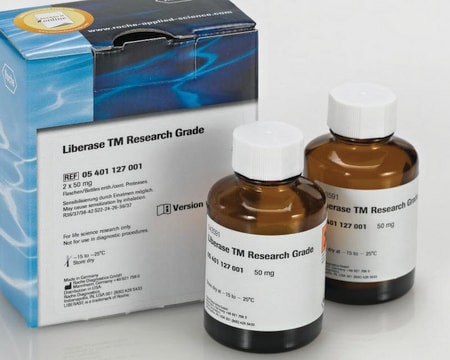Key Documents
D4263
Deoxyribonuclease I from bovine pancreas
Standardized vial containing 2,000 Kunitz units of DNase I (D4527), vial of ≥0.25 mg total protein
Synonim(y):
DNase I, Deoxyribonucleate 5′-oligonucleotido-hydrolase
About This Item
Polecane produkty
pochodzenie biologiczne
bovine pancreas
Poziom jakości
Postać
powder
aktywność właściwa
1700—2300 U/vial
masa cząsteczkowa
~31 kDa
oczyszczone przez
chromatography
opakowanie
vial of ≥0.25 mg total protein
metody
DNA extraction: suitable
rozpuszczalność
0.15 M NaCl: soluble 5.0 mg/mL, clear
przydatność
suitable for molecular biology
Zastosowanie
diagnostic assay manufacturing
diagnostic assay manufacturing
temp. przechowywania
−20°C
Szukasz podobnych produktów? Odwiedź Przewodnik dotyczący porównywania produktów
Zastosowanie
Działania biochem./fizjol.
Cechy i korzyści
Versatile applications: This enzyme can be used to nick DNA, incorporate labeled bases into DNA, and isolate and molecularly characterize cancer stem cells in murine breast tumors. It is also useful in comparative studies of deoxyribonuclease isolated from bovine, ovine, and porcine pancreas.
Stable: The enzyme remains active for up to five hours at 60 °C between pH 5 and 7, and can be stored for up to a week at −20 °C with minimal loss of activity. This stability makes it a cost-effective and convenient option.
Definicja jednostki
Uwaga dotycząca przygotowania
Komentarz do analizy
inhibitor
Hasło ostrzegawcze
Danger
Zwroty wskazujące rodzaj zagrożenia
Zwroty wskazujące środki ostrożności
Klasyfikacja zagrożeń
Resp. Sens. 1
Kod klasy składowania
11 - Combustible Solids
Klasa zagrożenia wodnego (WGK)
WGK 3
Temperatura zapłonu (°F)
Not applicable
Temperatura zapłonu (°C)
Not applicable
Środki ochrony indywidualnej
Eyeshields, Gloves, type N95 (US)
Certyfikaty analizy (CoA)
Poszukaj Certyfikaty analizy (CoA), wpisując numer partii/serii produktów. Numery serii i partii można znaleźć na etykiecie produktu po słowach „seria” lub „partia”.
Masz już ten produkt?
Dokumenty związane z niedawno zakupionymi produktami zostały zamieszczone w Bibliotece dokumentów.
Klienci oglądali również te produkty
Produkty
To standardize a procedure for the enzymatic assay of Deoxyribonuclease I at Sigma-Aldrich St. Louis.
Protokoły
Standaryzacja procedury enzymatycznego oznaczania deoksyrybonukleazy I.
Nasz zespół naukowców ma doświadczenie we wszystkich obszarach badań, w tym w naukach przyrodniczych, materiałoznawstwie, syntezie chemicznej, chromatografii, analityce i wielu innych dziedzinach.
Skontaktuj się z zespołem ds. pomocy technicznej










